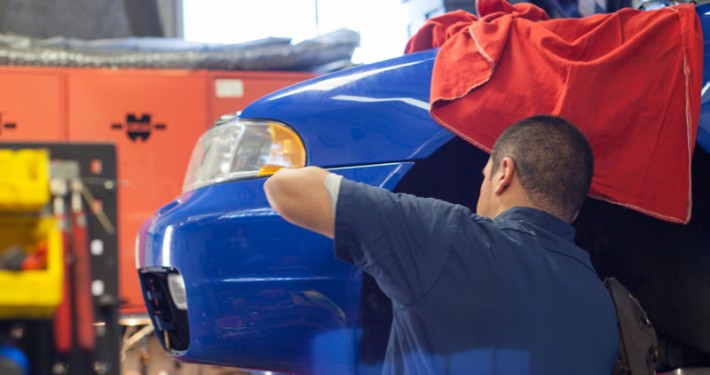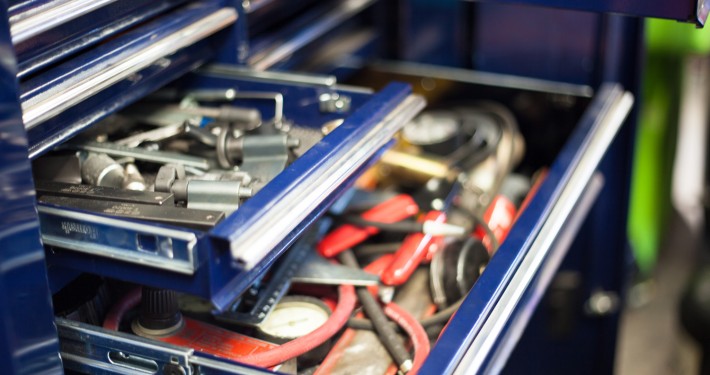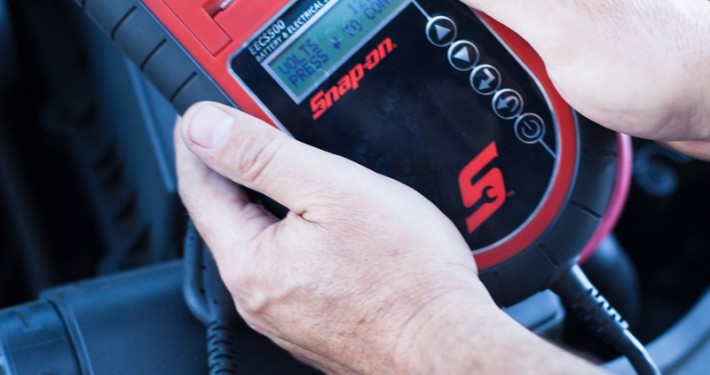BRAKES
INCLUDES: A thorough road test, inspection of vehicle, cleaning and resurfacing mounting hubs, sliders and brackets, installing new rotors, pads, bevel pads, apply high temp brake lubricant, check and clear abs module if applicable, torque all hardware to specs, road test and seat pads.
FAQ: Why do my brake rotors need to be replaced or resurfaced when brake pads are replaced?
First, brake rotors are usually made from cast iron. By the time your brake pads are ready to be replaced, there are grooves and deep wear marks worn into the wear surface of the brake rotors. The job of the brake rotor is to dissipate heat during braking. If we were to install new brake pads on the worn rotors, the new pads would only contact the high spots, thus decreasing the available friction surface and heat transfer. In addition, modern brake pads are made from hundreds of inorganic materials that wont “form” to the worn rotors as easily as the pads made in years past. Also, on most front brake rotors, it is sometimes prudent to replace the rotors to maintain a larger mass of material to dissipate heat. Resurfacing rotors is a process that removes the outer layers of the rotor to reveal a clean, flat, microfinished surface that will allow the new brake pads to “seat” and further cure the compound in the brake pads. On today’s high performance front drive vehicles such as VW, Audis, and BMWs, it is not uncommon for a front end brake job to return several months later with warped brake rotors. It often makes more sense to replace front rotors and maintain a larger, thicker mass of material to prolong brake life and performance in the long run. On the other hand, some manufacturers such as Mercedes Benz, routinely install only brake pads if the minimum thickness of the brake rotors are within factory specifications. In these cases, we discuss the pros and cons of the outcome with the owner and install only genuine Mercedes Benz brake pads.
It should be noted that the primary complaint we hear from customers regarding brake operation is noise. Noise can be tracked down to several factors such as types of pads, cleanliness during installation, worn front suspension components, and insufficient or missing brake hardware or lubrication. But the main reason, we find, is that poor quality brake pads with insufficient cleaning and lubrication were installed on worn, unfinished brake rotors.
DIAGNOSTICS
Typically, all diagnostics including check engine light troubleshooting, runs one to one and one half hour labor. At our discretion, depending on what was involved, some or none of your diagnostic time will be applied to the repairs. Many times, we have to use the 6150b guided fault finding or guided functions to establish a course for repair. These tools cost tens of thousands of dollars to procure and maintain. There is a big difference between a quick lube free “diagnostics” check, and the time spent using OEM level tools. Often, we have to call upon parts schematics,wiring diagrams, or online paid services from the manufacturer to obtain the latest technical service bulletins,upates, and repair information. These costs, along with the troubleshooting, is what you are paying for.
INCLUDES: A road test, thorough inspection when time permits, diagnostic and estimate to repair. Often times, the labor will include installation of parts (ie broken vacuum hoses, simple repairs), but due to the wide range and variety of problems we encounter, there is no way to quote an exact price. At our discretion, time permitting, we do not charge to connect the scanner and read the engine fault codes for VW and Audi. We do charge a minimum fee to use our Autologic on BMW and MB vehicles.
FAQ: What does it mean when the “check engine” light comes on in my car?
The check engine light is designed to inform you of an emissions related problem with your engine. After 1996, a system called OBD2 is built into every car’s programming. In simple terms, your onboard computer analyzes thousands of bits of data from input and output sensors to make sure your engine is running within parameters set up by the OBD2 engineers. The idea was to create a universal system that governing bodies could use in car manufacturing that would ensure cars would have to be running clean and efficient to protect our environment. Your onboard computer monitors the oxygen sensors (devices that measure fuel to air mixture), the catalytic converter ( an exhaust device that converts harmful engine emissions into more environmentally friendly compounds), the ignition system, the fuel system, and the evaporative emissions systems. When one of these systems is malfunctioning, the onboard computer makes a decision to turn on the check engine light to inform the driver that service is required.
Your light may come on for a day and not return, or come on once, and then not return. This means there is a problem and the fault is stored in the computer’s memory awaiting retrieval. The light turned off because the system it is checking has a failure test that is not entirely complete, or it may take more drive cycles to complete before turning the light on solid.
We are happy to download the fault codes and help you decide if it is safe for you to continue driving your car. Rule of thumb for the check engine light is get it checked as soon as possible. Most of the time, you are completely safe driving your car home. If your car is misfiring (the engine seems like it is idling rough, lack of power, hard to start, check engine light on), you should cease driving the car and have it towed. Driving your car with a misfire can lead to serious emissions problems including ruining your catalytic converter.
MAINTENANCE
example: Oil and filter, air filter, cabin filter, fuel filter, spark plugs, coolant service, brake flush, tire rotation (if necessary), and all additional checks and adjustments listed by the manufacturer at this mileage interval.
VW 40/80/120k miles
Audi 30/60/90k miles
BMW / MINI maint 1, maint 2, or CBS (condition based service)
MB service level A B C etc
Please note: VW and Audi made a major change to the maintenance schedules after model year 2005. The guides now reflect even longer oil service intervals and modified filter replacement. Most manufacturers did this to make their cars appear to require less maintenance, and be viewed as more economical. In reality, the powertrain actually became more sophisticated and complex, and we are now seeing the effects of these prolonged services. Worn camshafts, premature timing chain and guide failure, and engine sludge to name a few.
Models built after 2005 should be maintained by following the manufacturer schedule, at minimum. It doesnt hurt to exceed the oil change interval to five thousand miles. Almost every model now uses full synthetic motor oil, and specific engines have specific motor oil varieties that must be used. Call us or consult your service booklet for details.
FAQ: What is a major service?
Generally speaking, a major service occurs every thirty to forty thousand miles in the regularly schedule maintenance period. Different manufacturers specify different intervals depending upon several factors. Usually, deciding factors are how the vehicle is used, types of sparkplugs that the factory installed, and to some degree, to show that the vehicle requires very little maintenance when compared to a similar model. In the real world, even though a manufacturer may specify leaving the sparkplugs in the car until 100k miles, it is not uncommon to see misfires, poor mileage, and other drivability issues directly related to parts that just cant operate that long. For example, most manufacturers, such as VW, do not specify a replacement interval for the fuel filter. In real life, it is very common to see clogged fuel injectors on later model V6 engines. Although it hasn’t been shown that the fuel filter is the culprit, it doesn’t hurt to replace it at least once in a 100k mile period. You can easily spend $3-400 dollars troubleshooting and repairing for a misfire due a clogged fuel injector, and only $50 or so to replace the fuel filter.
(a) Our major service normally includes the following: road test performance and rack vehicle for complete underhood and underbody inspection. Change oil and filter, replace sparkplugs, replace engine air filter, replace cabin intake filter, replace fuel filter, change coolant, flush brake system, service battery, top all underhood fluids, inspect all hoses for wear , check for engine oil and coolant leaks, check front and rear brake condition, check front and rear suspension components for wear, check all driveshaft boots, inspect exhaust and hangers, adjust tire pressures,rotate wheels if necessary, check all lights, check all indicators, check wipers and washers, check air conditioner function, adjust timing, mixture and idle when applicable, check onboard diagnostics with appropriate scanner, final road test and quality check.
(b) Of course, some models require replacement of the distributor cap and rotor, while others require valve lash adjustment and other checks. Prices vary depending upon the parts required and the time it takes to perform the operations.
TIMING BELT
Recommended at 60-105k miles depending on your engine type, model, and year.
INCLUDES: timing belt, tensioners, dampner, rollers (if applicable), water pump, thermostat (2.8l), and serpentine belts.
FAQ: What is a timing belt job?
The timing belt can be found on 4,5,6, and 8 cylinder engines. The purpose of the timing belt is to maintain the correct camshaft, balance shaft, and crankshaft timing in order to keep the engine running. Simply put, it is a toothed rubber long life belt that is usually hidden under covers and accessories that needs to be replaced at a specified mileage interval. Failure of the timing belt or any of the idlers or tensioners which make up the timing belt system can result in disastrous results for the engine.
The timing belt job, when done properly, includes the replacement of the belt, the tensioner, the idler wheels and sometimes the water pump when it is directly driven by the timing belt. The reason these parts are all serviced, regardless of their condition, is so that the life of the new belt can be accurately predicted. Since the belt will only last as long as the weakest component, replacing all the parts that affect its longevity makes good sense. In addition, since the labor involved to access the timing belt is often substantial, it also makes good sense to service any leaking oil seals, tensioner dampeners, and accessory drive belts at the same time. The added cost in labor and parts is usually minor when compared to the cost savings in the long run.
FAQ: When do I change my timing belt?
The answer to this question all depends upon manufacturer, make and model. As a rule, 60k miles is the generally accepted replacement interval for most cars. This can change, however, if you drive a diesel, a manual transmission versus an automatic one, or on the model year. It is always a good idea to check your maintenance book for the recommended mileage interval or call us to find out. Most newer cars after 1999 have timing belts which are supposed to last until 105k miles. Don’t always trust this interval. It’s prudent to check with the manufacturer’s technical service bulletins for the latest updates. Premature timing belt tensioner failures and water pump bearing failures are two common reasons these belts don’t always make it to 105k. Sometimes, it is better to just replace it by 80-90k and play it safe.
OIL CHANGES
Todays complex european cars no longer enjoy simple oil changes. For one thing, its no longer a simple 15 minute operation. Most cars have plastic guards and undershields that inhibit access to the oil filter and oil pan. When the car is up on the lift and the oil is draining, its a good time to inspect the brakes, the tires, the cv boots, and any fluid leaks. By California State law, we must check and adjust your tire pressures to the label on your door or fuel cap, and then determine how to reset the service reminder on your instrument panel or MMI display. This often means using the VAS 6150b, VagCom, or even Autologic if its a BMW or Mercedes. All these operations easily take one half hour or longer. Many times, there is a lamp out, or wiper blades are needed. Usually, the tire pressure monitor system will also need to be reset. In reality, the oil change evolved to become the oil service.
EVERYTHING ELSE
In addition to the listed services, we service air conditioning, suspension, body electrical systems, convenience systems, supplemental restraint systems and much more. We can recode your keys and get the SKC for most of the Volkswagen and Audi models too.
Newer model direct injection equipped engines are suffering from misfires and power loss due to carbon buildup on the intake valves. We offer complete valve cleaning service with walnut shell blasting. The service is far superior to any chemical or vapor treatment your local dealer will prescribe.




